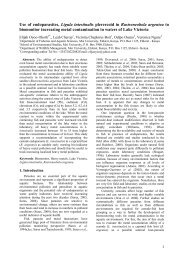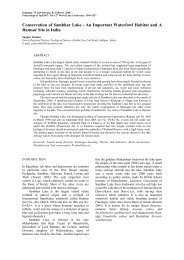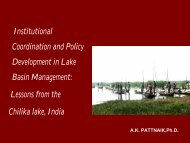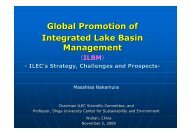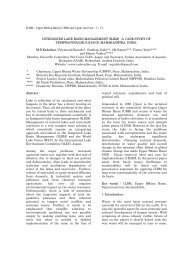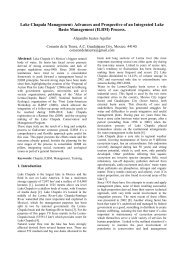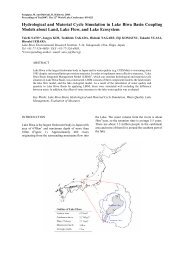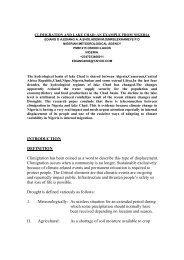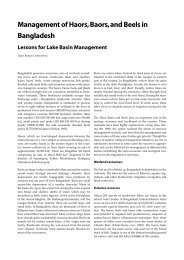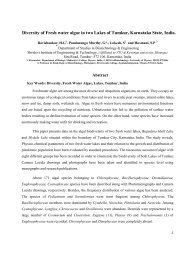Presentation
Presentation
Presentation
Create successful ePaper yourself
Turn your PDF publications into a flip-book with our unique Google optimized e-Paper software.
Management of haors, baors, and beels in<br />
Bangladesh: Lesson for Lake Basin management<br />
Tapas Ranjan Chakraborty<br />
Center for Natural Resource Studies
Haor<br />
Baor<br />
Beel<br />
Beels are scattered over the country
Agriculture<br />
Irrigation<br />
Fish<br />
Lake resources<br />
Cattle<br />
Medicine<br />
Navigation<br />
Livelihood<br />
Lake ecosystem in Bangladesh supports atleast<br />
240 species of Fishes<br />
125 Species of waterfowls<br />
Flood control<br />
The seed from the fruits of water lily is an important item of food.<br />
Biodiversity<br />
The livelihood of a large number of community is totally dependent of the<br />
lake resources, like Kaibarta<br />
Maimal<br />
Bazbangshi
Threats of Lakes<br />
Disappearing Pollution Over harvesting of the<br />
natural resources<br />
Land use conflict<br />
Lack of up stream water flow<br />
Flood<br />
Saline<br />
Land erosion Siltation Development activities<br />
• In the early 19th century Chalan Beel used to cover an<br />
area of about 1,085 sq km but it was reduced to 368 sq<br />
km in 1909, of which only 85 sq km remains underwater<br />
throughout the year. It has since shrunk to only 26 sq km.
Institutions involved in Lake Management in Bangladesh<br />
Number of Government and Non Government Organizations are involved in lake<br />
Management in Bangladesh. Example-<br />
Government Institutes (Departments)<br />
•Bangladesh Water Development Board (BWDB)<br />
•Department of Environment<br />
•Department of Fisheries<br />
•Ministry of Land<br />
•Local Government Engineering Department (LGED)<br />
•Space Research and Remote Sensing.<br />
I/NGOs<br />
•Center for Natural Resource Studies<br />
•Bangladesh POUSH<br />
•Bangladesh Center for Advanced Studies<br />
•BRAC<br />
•NACOM<br />
•CFSD<br />
•IUCN<br />
•Practical Action<br />
Universities<br />
CBOs
Legislations on lake management<br />
The Haor Development Board Ordinance, 1997<br />
Bangladesh Environmental Conservation Act 1995<br />
East Bengal Protection and Conservation of Fish Act, 1950<br />
Bangladesh Wildlife (Preservation) (Amendment) Act, 1974<br />
The East Bengal State Acquisition and Tenancy Act, 1950<br />
The Land Reform Board Act, 1989<br />
Beside the<br />
national Laws,<br />
Bangladesh is<br />
signatory of<br />
Ramsar, CITES,<br />
CMS, etc.<br />
Wetland inhibitors follow number of<br />
Cultural and Religious norms, like<br />
Secret wetlands: Pana tirtha, Sumeswari<br />
Secret Rivers: Brahmaputra, Sitalaskha<br />
Ban of Harvesting: Fish fry in Manikganj District<br />
No Fishing: No fishing on Friday in Sundarban<br />
Poverty interferes norms
Good Practices<br />
• Tangua Haor (100 sq km of which 2802.36 ha is wetland, Ramsar Site)<br />
• Hail Haor<br />
• Hakaluki Haor (in rainy season 4,400 ha, in dry season 4,400 ha)<br />
• Marjat Baor (200 ha)<br />
• Chalan Beel (368 sq km)<br />
• Chanda Beel (60 sq km )<br />
• Arial Beel (723 sq km )<br />
Number of projects have been implemented in<br />
Bangladesh for the Management of Wetlands. Some<br />
of the Good Projects and Tools are described in<br />
the following slides. Most of this projects and tools<br />
were practiced in large wetlands, like
MEGHNA-DHONAGODA PROJECT by BWDB<br />
�Water Users Organization formation<br />
for water management<br />
�Involvement of Water User Group in<br />
cost recovery<br />
�Involvement of distress woman in<br />
embankment maintenance<br />
�Integrated Pest Management<br />
�Small Scale Fisheries Development
Community based Haor and Floodplain Resource Management Projects<br />
under SEMP<br />
CNRS worked<br />
for Haor,<br />
NACOM and<br />
BCAS worked<br />
for Padma-<br />
Jamuna,<br />
Brahmaputra –<br />
Stalakha<br />
floodplains;<br />
and the<br />
Madhumati<br />
floodplains<br />
respectively.<br />
Project<br />
Started<br />
Community<br />
Organizations<br />
Baseline<br />
Study<br />
Awareness<br />
Generation<br />
Habitat<br />
Restoration<br />
Intervention<br />
Environmental<br />
Fund<br />
Participatory<br />
Action Plan<br />
Development<br />
Sustainability<br />
Demonstrations
Community-Based Haor Resources Management under Sustainable<br />
Environment Management Program (SEMP 2.2.1/A) by CNRS<br />
Pangner Haor<br />
Sanuar Haor<br />
Hakaluki Haor<br />
5 years<br />
Community<br />
Local Govt<br />
Awareness<br />
NRM<br />
Alternative<br />
livelihoods<br />
Fish<br />
Sanctuary<br />
Participatory planning<br />
Community Groups<br />
Capacity Building Empowerment<br />
Swamp forest<br />
plantation<br />
Green<br />
fund
Management of Aquatic Ecosystem through Community Husbandry<br />
(MACH)<br />
The project included realistic activity packages which covers<br />
household level livelihood planning and intervention,<br />
� training needs assessment,<br />
� awareness and institution building,<br />
� habitat rehabilitation,<br />
� afforestation,<br />
� wise use of fish and other wetland resources,<br />
� establishment sanctuaries,<br />
� community development & local level institution building and<br />
� social and biological monitoring.
Community Based Fisheries Management (CBFM)<br />
community control over 116 water bodies has been established through 130<br />
officially recognised, poverty-focussed, Community Based Organisations<br />
Prime objectives of CBFM<br />
•to ease the growing fishing pressure and stop fishing during the breeding<br />
season, usually for a three-month period – April to June each year.<br />
•to establish fish sanctuaries where no fishing is allowed.<br />
Sanctuaries are demarcated with<br />
red flags, accompanied by a<br />
signboard declaring that fishing is<br />
completely banned in the sanctuary.<br />
164 fish sanctuaries covering over<br />
90 hectares of water area have<br />
been established in 81 water bodies.
Costal and wetland Biodiversity Management Project (CWBMP)<br />
Has been implanted since 2006 In the Ecological Critical Areas, viz.,<br />
Sonadia Island, St. Martin’s Island and Teknaf Peninsula and in Hakaluki Haor.<br />
Object of the project is sustainable management of natural resource through<br />
community groups.<br />
Ecologically Critical Areas (ECAs) were declared under the 1995<br />
Environmental Conservation Act (1995).<br />
Village Conservation<br />
Groups Formation<br />
Awareness<br />
Alternative<br />
Income<br />
Generation<br />
Green Fund<br />
Enforcement of ECA Law<br />
Sustainable<br />
Harvesting<br />
Conservation
Costal and wetland Biodiversity Management Project<br />
The ECA notification identifies the<br />
following activities as prohibited:<br />
•Felling or extracting of trees and<br />
forest;<br />
•Hunting and poaching of wild<br />
animals;<br />
•Catching or collection of snail, coral,<br />
turtle and other wild animals;<br />
•Establishment of industries that may<br />
pollute soil, water, air and/or create<br />
noise pollution;<br />
•Any activity that is likely to threaten<br />
the habitat of flora and fauna<br />
•Any activity that is likely to destroy/<br />
alter the natural characteristics of soil<br />
and water,<br />
•Any activity that is likely to cause<br />
harm to fish and other aquatic life
Problem Census<br />
Community members are divided into separate<br />
Stakeholder groups (e.g. fishermen, farmers, etc.) to<br />
identify the problems they face in their communities and<br />
solutions.<br />
Problem Cluster and Prioritisation<br />
Secondary stakeholders (e.g. chief executive of a subdistrict<br />
(UNO); fisheries and agriculture officers, union<br />
parishad chairman, NGO representatives.) join with<br />
primary stakeholders to discuss and prioritise problems<br />
related to natural resources management.<br />
Analysis of solutions<br />
Separate stakeholder groups appraise identified<br />
solutions to assess the socio-economical, technical,<br />
environmental, political and sustainability (STEPS)<br />
impact of the actions needed to achieve the solutions.<br />
Consensus on Solutions<br />
Primary and secondary stakeholders jointly review the<br />
compiled analysis of solutions recommended by<br />
separate primary stakeholder groups and agree<br />
potential solutions<br />
End product of PAPD is a<br />
consensual community<br />
action plan<br />
Participatory Action<br />
Plan Development<br />
After a PAPD, communities<br />
develop a more detailed<br />
action plan, which will be<br />
implemented through existing<br />
or newly formed local<br />
community institutions.
Participatory Action Plan Development
Community based Fish Sanctuary<br />
The community based fish sanctuary is<br />
community announced and practices project<br />
areas that is a no fishing zone with a core<br />
area and a buffer zone.<br />
Buffer zone<br />
Core area<br />
Controlled<br />
Fishing<br />
No<br />
fishing<br />
Open for<br />
fishing<br />
demarcated with red flags and filled with branches or tree roots as fish<br />
shelter and keep no fishing possible
BAIRA -Floating Garden<br />
� Baira is an indigenous practice of the<br />
farmers in southwest districts of<br />
Bangladesh<br />
� Baira is a floating platform made of water<br />
hyacinth<br />
� Is used as seed bad and for growing<br />
vegetable and spices<br />
� 23 species of vegetable and 6 species of<br />
spices have been successfully produced<br />
and harvested<br />
Leaf<br />
Root<br />
Water Hyacinth<br />
To construct a baira farmers usually follow<br />
the above mentioned damping approach
Restoration of Swamp Forest in Haor<br />
Select and delineate<br />
the site by the local<br />
people<br />
Involve community<br />
people and local labor to<br />
keep costs low & develop<br />
community support<br />
Secure the land<br />
lease agreement and<br />
resolve the land<br />
tenure conflict<br />
Prepare the site by<br />
making changes<br />
that allow natural<br />
process to occur<br />
Use adaptive<br />
management to<br />
adjust plants as<br />
needed<br />
Form restoration<br />
and advisory<br />
committees<br />
Produce seedlings/saplings<br />
by collecting materials from<br />
local stock, wild source,<br />
homestead areas, etc.<br />
Keep intact of existing<br />
vegetation cover and<br />
allow natural<br />
regeneration
Report Card<br />
Report card is a very simple, effective,<br />
participatory self-monitoring monitoring tool.<br />
Report Card allows the community to<br />
monitor the processes of any development<br />
program or activities in their command area.<br />
In this process, pictures are used to<br />
understand the activities<br />
Report card contents number of pages.<br />
One page is for one index. The<br />
indicators are described in picture. The<br />
community compare the progress of<br />
activities with the picture and score. In<br />
this page the calendar and watch is used<br />
as determine regularity and timeliness.
Institutional Arrangement for Sustainable Resource Management<br />
Community based<br />
People’s Ownership<br />
Good Governance<br />
Trade<br />
NR Craft<br />
Framing<br />
Off farm<br />
Democratic<br />
Capacity Building<br />
Organization<br />
Livelihood<br />
Institutional<br />
Support<br />
Sustainable<br />
natural<br />
resource<br />
management<br />
Policy<br />
Support<br />
Biodiversity<br />
Knowledge base<br />
Stock<br />
Renewal<br />
Participatory<br />
Right based<br />
Livelihood Focused<br />
Conservation Focused<br />
Empowering poor
Lake Basin management<br />
The wetland management practices in Bangladesh is appreciable.<br />
Though there are bottlenecks, like corruption, poverty, political<br />
instability, etc. But the experience from Bangladesh can be<br />
replicated to other lake basins considering the ecology and social<br />
aspects. Based on those the following are suggestions to<br />
manage large lake basin:<br />
Involve local community in management (through PAPD)<br />
Ensuring Access to existing resource and Investment<br />
Explore scopes from exiting legislations rather than having new law<br />
Involve/Establish a community institution for monitoring<br />
Making conservation/protection economically valuable to community<br />
Respecting and Integrating Indigenous Knowledge<br />
Practice a culture of sharing benefit among the stakeholders<br />
Mass awareness and education on the practiced management through<br />
significant number of tools/event<br />
Ensure involvement of Government in every stages
Thank you



